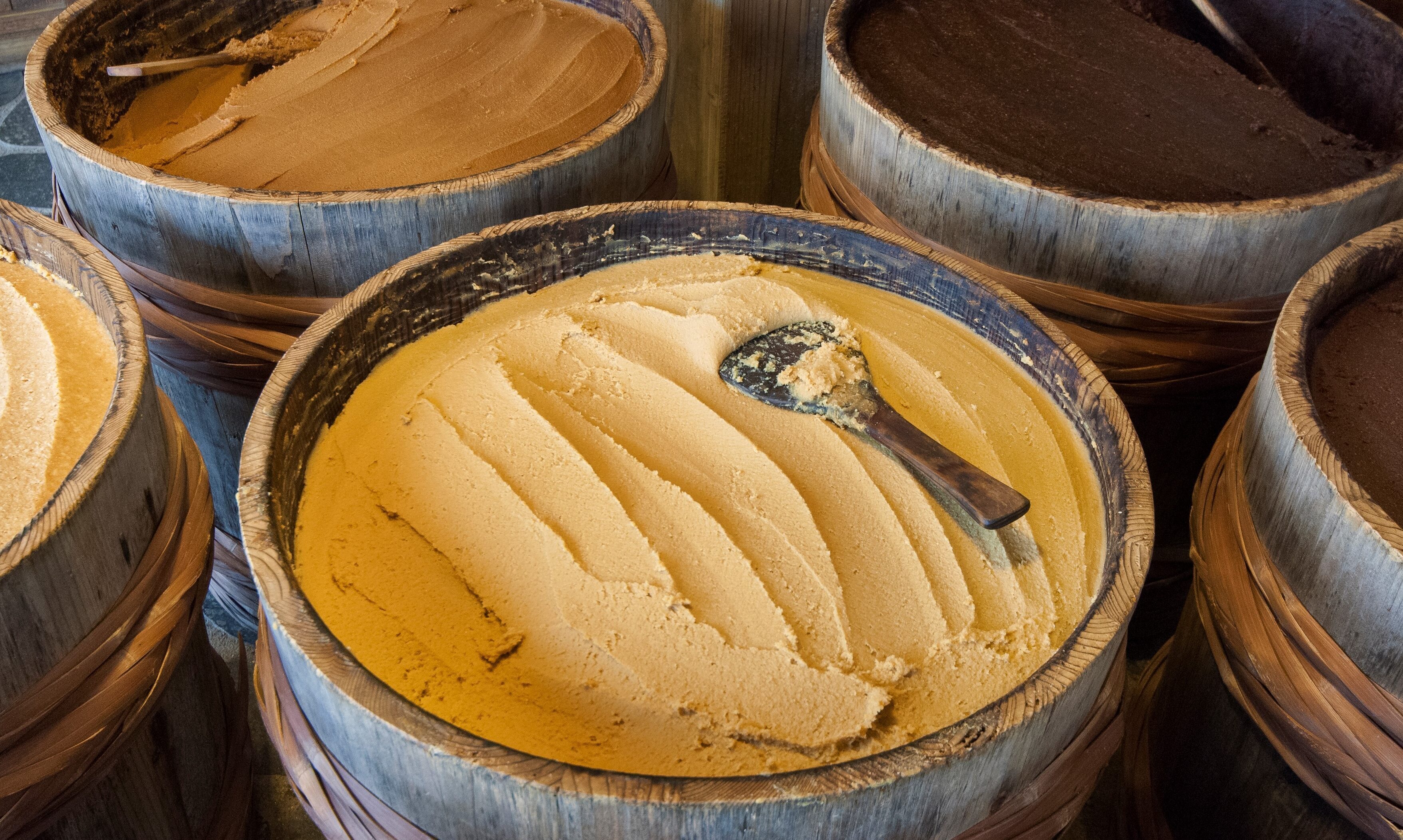February 21, 2023 | Ingredients 101 Food Trends Product Education
What is Miso? The Complete Miso Guide

As predicted in our Roland Foods’ 2023 Fine Foods Industry Trends and Predictions Guide, umami flavors are on the rise! One of the quintessential umami ingredients is miso. What is miso? Miso paste, a highly recognizable and distinct umami-rich food, is an ancient ingredient dating back centuries. Dive into the background, varieties, cooking applications, and modern uses of the paste in our comprehensive miso guide.
The History of Miso:
While miso paste is most often associated with Japanese cuisine, its origins can be traced back to early 4th century China. It is believed that the paste was originally introduced in Japan nearly 1,300 years ago by Buddhist priests. Current day miso paste is the Japanese adaptation of the Chinese fermented soybean paste. This ingredient was originally reserved only for the noble and wealthy, as it was extremely valuable and expensive. In its first uses, the paste was eaten on its own or simply spread directly onto food, whereas now it is primarily used for seasoning and cooking.
How to Make Miso Paste: The Fermentation Process
Miso paste is comprised of three main ingredients, soybeans, grains, and koji.
Koji is a fungus derived from bacteria culture and rice. When the two are fermented, the result is the microbe culture Aspergillus oryzae, or Koji. This process, similar to making a sourdough starter for bread, can take up to two days.
The paste is then created by blending cooked soybeans, the koji, and various grains. This mixture must then be left for 6-12 months to ferment. Once the fermentation process is complete, the resulting miso will keep for several years!
Types of Miso Paste

There are many variations of miso, each distinguished by the grain used and the duration of the fermentation process. A general rule of thumb for understanding the types of miso: the deeper the color, the longer the fermentation process, and the stronger the flavor. The three major types include:
Shiro Miso
More commonly referred to as “white miso”, this variation is the most popular. The grain used in Shiro miso is rice, and the fermentation process is much shorter than most. As a result, white miso paste is more delicate in flavor and even has a touch of sweetness in comparison to other types.
Discover our Roland® White Miso Paste
Aka Miso
Also known as “Red Miso”, this is the strongest and darkest variation of miso paste. Aka Miso uses a mixture of barley, soybeans, and various other grain blends, which produces a paste dark in appearance with a red or brown tint. Red miso has the longest fermentation duration, around one to two years, which creates its dark color and rich flavor. This variety, which is also the most protein-dense, has the most potent flavor and thus should be used sparingly --a little goes a long way!
Awase Miso
A combination of Shiro Miso and Aka Miso, Awase miso falls right in the middle of appearance and taste, making it the most versatile type of paste.
Chef Tip: Experiment by mixing white and red miso paste at home to create your own Awase Miso!
Flavor Profile and Nutritional Benefits
While the strength of flavor in each type of miso paste varies, the ingredient is generally described as tangy, salty, and umami-rich. Umami, which translates to in Japanese to “essence of deliciousness,” has meaty, salty, and savory characteristics. Miso paste, like other fermented foods, is known to help aid in digestion. Fermentation makes foods easier to digest by breaking down nutrients and increasing bacteria and probiotics in your gut. Miso paste is also rich in vitamins and minerals, making it a nutrient-dense superfood!
Cooking with Miso
Miso paste is ready to use directly from the container. You can even eat it as is, as it was originally consumed. Now, however, the most common use is for seasoning and cooking.
When cooking with miso, be careful! Remember, it is full of micro bacteria, which will die when boiled. Without bacteria, the paste loses its nutritional benefits, plus boiling it will ruin its umami flavor! It is best to use miso at the end of a long cooking process to avoid overheating.
Miso Soup

Perhaps the most famous and loved application of miso paste is in miso soup. Some studies have shown that up to 75% of Japanese people eat miso soup daily, and 70% consume it for breakfast. Miso soup has ancient roots in Japan and was especially important to the Japanese Samurai and during the Japanese Civil Wars. It is said it was invented for military purposes because it was accessible, simple to make, and easy to carry around.
Did you know? There is a “proper etiquette” when it comes to eating miso soup! Traditionally, miso soup is not eaten with a spoon, but rather sipped directly from the bowl. Both hands should support the bowl, with your dominant hand on the bottom. Any solid contents like tofu or seaweed are to be eaten with chopsticks!
Modern Cooking Applications
Aside from miso soup, the umami-packed paste has become a trendy ingredient in many modern dishes. Miso paste is now commonly added in salad dressings and vinaigrettes, used for marinating proteins (especially fish), or as a glaze on vegetables and meats!
Check out our recipe for Miso Compound Butter!
Miso is also a popular ingredient in fusion food. Cuisine crossovers are trending, and cooks are more inclined to utilize potent flavors, like miso, with other surprising ingredients.
Check out our miso paste cuisine crossover recipes for Miso Roasted Carrots with Citrus Black Truffle Crema and Italian Fusion Tantanmen Bowl.
Miso in Modern Dining…and Drinks!
Craving a miso dish? Below are some of our favorite restaurant miso applications:
- Sweetgreen Miso Bowl – A popular QSR, Sweetgreen is known for making delicious and nutritious salads. We love their Miso Bowl, which incorporates miso glazed vegetables and miso sesame ginger dressing!
- Nobu Miso Caramel Ice Cream Bon Bon- Nobu is one of the most famous Japanese fine dining restaurants, beloved by celebrities. Their menu is filled with miso dishes from glazed cod to shishito peppers with miso, but it’s their Miso Caramel Gelato that caught our eye! This savory dessert is available at their downtown NYC location.
- Red Paper Clip Miso Aioli – The seasonal menu from Red Paper Clip in NYC currently features two miso dishes. Check out the Hot Chicken Sandwich with Miso Aioli and the Everything Brioche with Miso Yolk.


Bartenders and mixologists are getting creative with miso paste too, as miso infused cocktails are popping up on more menus. The Wiggle Room, a popular NYC bar, has already hopped on this trend. Check out their “Slam Dunk Disco” cocktail with mezcal, reposado tequila, aveze, white miso, banana, and apricot.
Incorporating miso paste into cocktails adds complexity to otherwise one-dimensional drinks and balances sweet and savory notes. Introducing miso paste behind the bar is also a great way for restaurants to reduce food waste and stretch spending budgets.
Must Have Miso
With more than 85 years of experience in the fine foods industry, we consider ourselves experts on global flavors, and we love to share that knowledge with our customers. We hope this guide has been informative and useful for future experimentation with miso paste.
Explore our other blogs and product spotlights to continue your culinary education!
Related Products
Recommended Reads
August 23, 2024 | Food Trends Foodservice Guides
Saucy Sensation: Dipping into Global Taste and High Impact Flavors
Discover the world of global sauces and condiments and learn how they can transform dishes and enhance flavors. Follow along as we delve into regional origins, preferences and trends, and foodservice opportunities within the sauce and condiments market.
February 20, 2024 | Food Trends Foodservice Guides
What is an LTO? Leveraging Limited Time Offers in Foodservice
What is an LTO? Limited Time Offers are a valuable tactic used widely across the foodservice landscape to boost sales and drive foot traffic. Learn more about the different types of LTOs, marketing strategies, and how Roland® can be your LTO partner in our comprehensive guide.
December 29, 2023
Cooking Oil Alternatives | Expand Your Pantry with Roland Foods
Navigating the Olive Oil shortage with Roland Foods. Expand your pantry with alternative cooking oils and custom blends.












